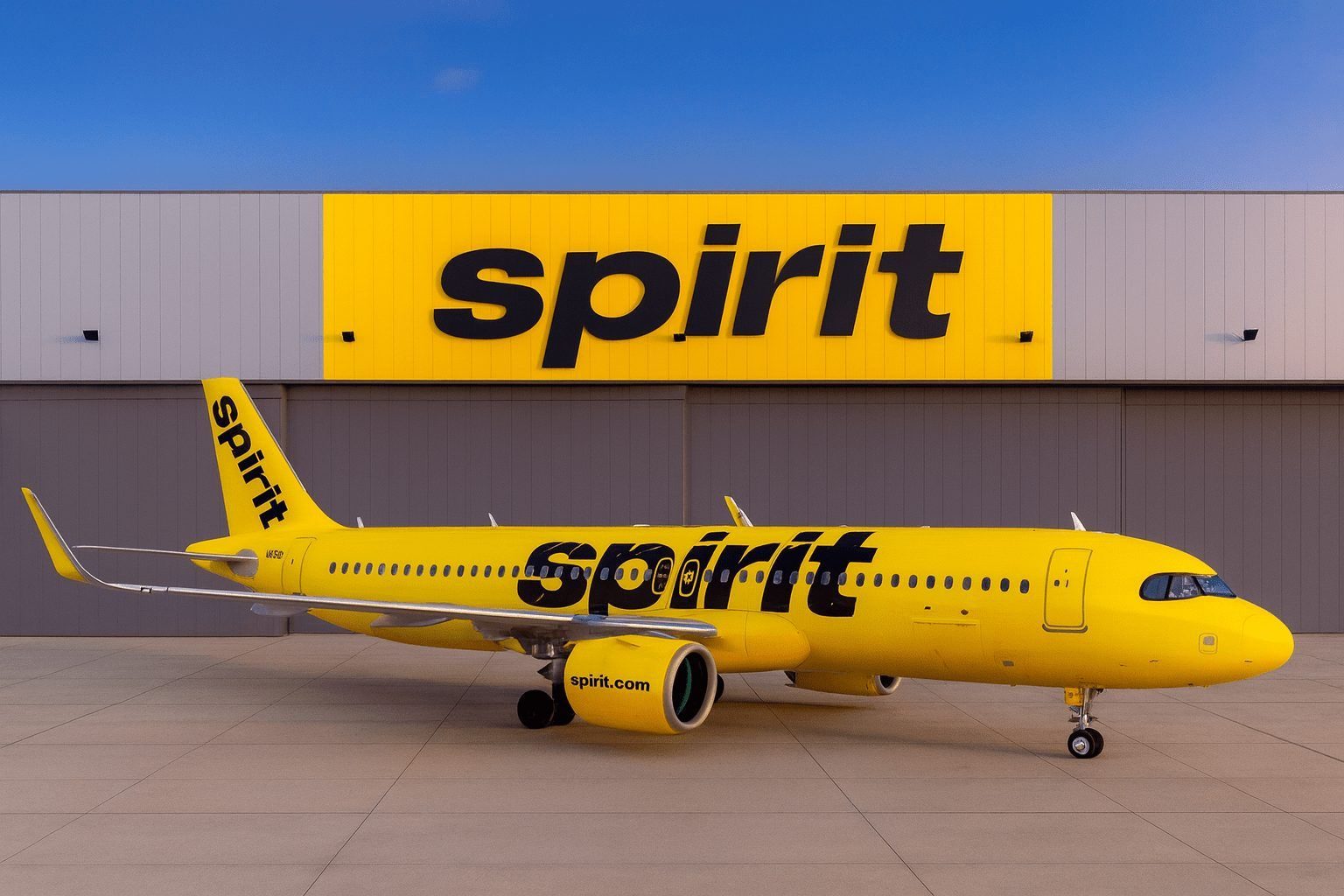As of Sunday, November 23, 2025, Spirit Aviation Holdings, Inc. (OTC: FLYYQ), parent of Spirit Airlines, is trading around $0.25 per share, giving the once high-flying ultra‑low‑cost carrier a market capitalization of roughly $6.7 million. [1] That puts Spirit firmly in penny‑stock territory after a brutal year that included two Chapter 11 filings, severe route cuts, large-scale furloughs and repeated warnings about its ability to stay in business. [2]
Today’s news flow is relatively light but still notable for equity holders:
- A fresh shareholder class-action alert from law firm Bronstein, Gewirtz & Grossman (BG&G) again urges FLYYQ investors with losses to seek lead‑plaintiff status before a December 1 deadline. [3]
- An analysis from Simply Wall St highlights how Spirit’s financial distress and capacity cuts could actually benefit American Airlines, by tightening the U.S. domestic market and supporting fares. [4]
No new Spirit corporate press releases or SEC filings hit the tape today; the latest company communications came last week with a monthly operating report, a debt‑tender update and the launch of a new international route from Fort Lauderdale to Belize City. [5]
1. Spirit Airlines stock today: FLYYQ as a distressed micro-cap
Ticker & trading venue
After being delisted from the NYSE American in the wake of its second 2025 bankruptcy, Spirit’s common stock now trades on the OTC Pink Limited Market under the symbol FLYYQ. [6]
Previously, investors knew the airline as:
- SAVE on the NYSE (Spirit Airlines, Inc.)
- SAVEQ on the OTC market during and immediately after the first bankruptcy
- FLYY on NYSE American after the March 2025 restructuring and relisting
Today, FLYYQ is the live equity for Spirit Aviation Holdings, Inc.
Latest quote & key stats (as of November 23, 2025)
Data from multiple market sources show: [7]
- Last price: ≈ $0.25
- Day range (last session): ~$0.22 – $0.34
- 52‑week range:$0.16 – $13.00
- Market cap: ≈ $6.7 million
- Price‑to‑book (P/B): ~0.04
- Trailing EPS: about –$11 per share
- Beta: roughly 2+, indicating very high volatility
Yahoo Finance’s historical data confirm the stock closed at $0.25 on Friday, November 21, with no change on the day, and flag a Q3 2025 earnings call scheduled for Monday, November 24 at 8:30 a.m. EST—a key near‑term catalyst for the stock. [8]
In short: Spirit’s equity is trading like a lottery ticket on a bankrupt airline, not like a typical listed blue‑chip.
2. All Spirit Airlines–related news today (23 November 2025)
2.1 New class-action alert targeting FLYYQ investors
The most direct Spirit‑stock headline dated November 23, 2025 comes from ACCESS Newswire and law firm Bronstein, Gewirtz & Grossman, LLC. [9]
Key points:
- BG&G reiterates that a securities class action is already filed against Spirit Aviation Holdings and certain officers.
- The class period runs from May 28, 2025 to August 29, 2025, spanning Spirit’s post‑relisting period and its run‑up to the second bankruptcy.
- The complaint alleges that management overstated improvements in Spirit’s financial condition and liquidity, while downplaying the risk that the airline could soon be forced into Chapter 11 again.
- Investors who bought FLYY/FLYYQ during the class period and suffered losses have until December 1, 2025 to seek appointment as lead plaintiff.
This release adds to a crowded field of law firms (Pomerantz, Kirby McInerney, Robbins LLP, Bragar Eagel & Squire, Portnoy Law and others) that have launched or advertised similar suits around Spirit’s 2025 disclosures and second bankruptcy. [10]
For shareholders, the immediate financial impact of these suits is uncertain—but they underscore that management’s communication and risk disclosures in 2025 are now under intense legal scrutiny.
2.2 Fresh analysis: Spirit’s pain as a tailwind for American Airlines
Also published today, Simply Wall St examines American Airlines Group (AAL) and argues that Spirit’s struggles may improve the investment case for American. [11]
Their thesis, in brief:
- Earlier this year, Spirit raised “substantial doubt” about its ability to continue as a going concern, even after emerging from its first bankruptcy. [12]
- Spirit’s aggressive capacity cuts and ongoing restructuring reduce low‑fare competition in key U.S. leisure markets. [13]
- With one ultra‑low‑cost competitor on life support, legacy carriers like American potentially benefit from firmer pricing, better load factors and improved profitability. [14]
While this article is not about Spirit as an investment in itself, it highlights an uncomfortable reality for FLYYQ holders: some market participants now see more upside in Spirit’s competitors than in Spirit’s own stock.
3. How Spirit Airlines ended up in “Chapter 22”
Spirit’s stock story in 2025 is impossible to understand without the back‑to‑back bankruptcies that earned it the informal label of a “Chapter 22” case—industry slang for a company that files Chapter 11 twice in short order. [15]
3.1 First Chapter 11: November 2024 – March 2025
- Spirit first filed for Chapter 11 in November 2024, becoming the first major U.S. airline to seek bankruptcy protection since 2011, after years of losses, failed merger attempts (including JetBlue) and heavy debt. [16]
- A U.S. bankruptcy judge later approved a deal converting $795 million of debt into equity and providing a $350 million equity investment from existing investors. [17]
- Spirit exited bankruptcy in March 2025 and initially traded OTC as SAVEQ, with plans to relist on an exchange and reposition itself as a more “premium” value carrier. [18]
- By late April 2025, its stock was approved to list on NYSE American under the new ticker FLYY. [19]
3.2 Warning signs: going‑concern doubts and credit downgrades
The second collapse didn’t come out of nowhere. In August 2025, Spirit’s quarterly filing warned that management saw “substantial doubt” about the company’s ability to continue as a going concern over the next 12 months, citing a toxic mix of: [20]
- Elevated domestic capacity
- Weak demand for domestic leisure travel
- Heavy debt and shrinking liquidity
Credit‑rating agencies reacted quickly:
- S&P Global Ratings downgraded Spirit Airlines LLC to ‘CCC’ with a negative outlook and later to ‘D’ following the second bankruptcy. [21]
- Fitch Ratings cut Spirit’s rating from ‘CCC+’ to ‘CCC-’, warning about mounting losses and deteriorating liquidity. [22]
3.3 Second Chapter 11: August 29, 2025
On August 29, 2025, Spirit filed for Chapter 11 protection again, this time under its new parent name Spirit Aviation Holdings, Inc. and NYSE American ticker FLYY. [23]
Key details from Reuters and company statements: [24]
- Spirit admitted that the first restructuring was too focused on balance‑sheet repair and did not fix an underlying bloated cost structure and fragile demand environment.
- The airline said operating expenses were running at about 118% of revenue, an unsustainable level.
- It planned to shrink its fleet and market presence, cut unprofitable routes and use Chapter 11 tools to renegotiate aircraft and airport leases.
- Shares, then trading as FLYY on NYSE American, plunged more than 40% and were later delisted, migrating to today’s OTC FLYYQ ticker. [25]
4. Inside the current restructuring: fleet cuts, DIP cash and asset sales
4.1 Massive fleet reduction and route cuts
As part of the second Chapter 11, Spirit has launched one of the most aggressive shrink‑to‑survive plans in modern airline history:
- The company intends to cut its fleet by nearly 100 aircraft, almost half of its 214‑plane fleet, rejecting 87 aircraft leases subject to court approval. [26]
- It is exiting more than a dozen U.S. airports and has already announced it will suspend roughly 40 routes as it focuses on core markets. [27]
- CEO Dave Davis told staff and regulators that November flight capacity would be cut by about 25% year‑over‑year, with further reductions next year. [28]
On the cost side, a landmark deal with aircraft lessor AerCap will: [29]
- Deliver $150 million in cash to Spirit
- Allow the airline to reject leases on 27 aircraft, removing hundreds of millions of dollars in future obligations
- Still provide for the future delivery of 30 aircraft, preserving flexibility if demand improves
Management says the fleet downsizing and lease rejections should generate “hundreds of millions of dollars” in annual savings, enabling a “smaller but stronger” airline. [30]
4.2 $475 million in DIP financing and improved liquidity runway
On October 10, 2025, Spirit obtained court approval for a multi‑tranche debtor‑in‑possession (DIP) facility of up to $475 million from existing bondholders. [31]
Important details:
- About $200 million of that DIP is available immediately.
- Additional tranches are expected through the remainder of 2025 as Spirit hits restructuring milestones. [32]
- The arrangement with AerCap (above) is tied into the broader DIP and restructuring plan. [33]
Spirit’s most recent filings also note that 96% of certain senior secured notes have been tendered in its bankruptcy process, suggesting major creditors are engaging with the restructuring. [34]
5. Jobs, unions and labor concessions
Spirit’s transformation has major implications for its workforce—and for investors evaluating long‑term operating risk.
5.1 Furloughs and job cuts
According to company statements and media reports: [35]
- Spirit plans to furlough about 270 pilots and demote 140 captains to first officers as part of early cost‑cutting rounds.
- Later disclosures indicate the airline will furlough a further 365 pilots, bringing total pilot furloughs above 600. [36]
- A separate move will see approximately 1,800 flight attendants—around one‑third of the cabin crew—furloughed from December 1, 2025. [37]
5.2 Union deals and pay cuts
The job cuts are being paired with wage concessions:
- On November 7, 2025, Spirit announced tentative cost‑saving agreements with unions representing pilots and flight attendants, part of a broader effort to secure bankruptcy financing. [38]
- On November 18, 2025, Reuters reported that unions formally agreed to pay cuts for both pilots and flight attendants, improving Spirit’s cash‑flow outlook but adding labor‑relations risk. [39]
Management has also imposed salary reductions on senior executives, though those moves are small relative to the scale of the fleet and staffing cuts. [40]
6. Management’s plan: big losses now, hoped‑for profit in 2027
In an October regulatory filing and accompanying commentary, Spirit laid out a multi‑year plan to return to profitability. [41]
Headline numbers from that plan:
- Expected net loss of about $804 million in 2025
- A smaller, but still sizeable, net loss of around $145 million in 2026
- Targeted net income of roughly $219 million in 2027, which would be the airline’s first profitable year since 2019
- Transformation plan expected to produce about $900 million in EBITDAR (EBITDA plus aircraft rent) in 2027
To hit those targets, Spirit is:
- Shrinking its network in 2026, then assuming modest growth from 2027 to 2029
- Cutting airline capacity another 20% in 2026 compared with current levels [42]
- Selling or “monetizing” a list of non‑core assets, including its Dania Beach headquarters, LaGuardia Airport slots and thousands of spare parts. [43]
For equity holders, the crucial question is whether that plan will leave any value for current FLYYQ shareholders once creditors are paid and new equity (if any) is issued under a final plan of reorganization.
7. Not all gloom: new routes and a “premium value” strategy
Despite its distress, Spirit is still doing real airline things—like adding routes and tweaking its product.
7.1 Belize City launch and Caribbean growth
On November 21, 2025, Spirit announced the launch of the only nonstop service between Fort Lauderdale (FLL) and Belize City (BZE), operating three times weekly. [44]
- The route expands Spirit’s international network from Fort Lauderdale to 24 destinations, more than any other carrier at that airport. [45]
- Belize follows recent launches to Key West (EYW), with Grand Cayman (GCM) to follow on December 4, 2025—part of a pivot toward higher‑yield leisure destinations in the Caribbean. [46]
7.2 Tiered product: “Spirit First,” Premium Economy and Value
As part of its post‑first‑bankruptcy repositioning, Spirit introduced three fare and cabin bundles: [47]
- Spirit First – Big Front Seat, included bags, no change fees, priority services and complimentary snacks/drinks
- Premium Economy – extra legroom or blocked middle seat, carry‑on included, priority boarding
- Value – lowest fares with à‑la‑carte options
The airline continues to receive industry accolades for value and frequent‑flier offerings, even as its finances reel. [48]
From a stock perspective, these moves show that Spirit is still investing in its brand and product, not simply winding down. But they also cost money and add execution risk at a time when the balance sheet is extremely fragile.
8. How the market is pricing the risk
8.1 Equity priced like an option on survival
Given the $0.25 share price and single‑digit‑million market cap, the market is effectively valuing Spirit’s existing equity as a deeply out‑of‑the‑money call option on a successful restructuring. [49]
By contrast, the company’s enterprise value (debt plus equity) is still in the hundreds of millions of dollars, highlighting that creditors, not shareholders, sit at the center of the capital structure. [50]
8.2 Analyst and credit views
- Equity analysts: Consensus data on FLYYQ show an overall “Sell” recommendation, with at least one data provider reporting 0 Buy, 0 Hold and 1 Sell rating, and others classifying the stock as a “Moderate Sell” based on a small analyst sample. [51]
- Credit markets: Ratings agencies Fitch and S&P have pushed Spirit deep into junk territory (CCC‑ and later D), signaling a high likelihood that existing obligations will need to be restructured and that default risk is high or has already crystallized. [52]
Those opinions don’t guarantee any particular outcome, but they align with the stock’s distressed trading behavior.
8.3 Legal overhang: wave of class-action lawsuits
Multiple law firms—including Pomerantz LLP, Robbins LLP, Kirby McInerney, Bragar Eagel & Squire, Portnoy Law, Shareholders Foundation and BG&G—have filed or advertised class actions on behalf of Spirit investors who bought during 2025. [53]
These suits generally allege that Spirit:
- Understated the risk of renewed bankruptcy
- Overstated the benefits of its first restructuring and strategy shift
- Failed to fully disclose liquidity and debt‑covenant risks
While class actions typically take years to resolve and may ultimately be borne by insurers or a reorganized entity, they add another layer of uncertainty around the equity.
9. Key things Spirit Airlines stock watchers should monitor next
For traders and longer‑term speculators still following FLYYQ, here are the big near‑term catalysts and risk markers:
- Q3 2025 earnings and November 24 earnings call
- Updated cash‑burn figures, liquidity runway and guidance on DIP drawdowns. [54]
- Plan of reorganization details
- Whether current FLYYQ shares are cancelled, massively diluted, or somehow carried into a reorganized entity. (In many airline bankruptcies, existing equity has ended up wiped out; investors should be prepared for that possibility.) [55]
- Court rulings in the Chapter 11 case
- Approvals for additional lease rejections, DIP amendments or asset sales, as reflected in the Spirit docket and related filings. [56]
- Ticket demand and competitive response
- Frontier, Southwest, United and others are already targeting Spirit’s core routes; how much market share Spirit retains will influence any 2027 profitability story. [57]
- Additional class‑action deadlines and settlements
- Today’s BG&G alert is one of several; future updates could affect perceptions of governance and disclosure risk. [58]
10. Bottom line for November 23, 2025
- Price: Spirit Airlines stock (FLYYQ) is hovering near $0.25, with a market cap under $10 million and extreme volatility. [59]
- Status: The airline is in its second Chapter 11 in less than a year, aggressively shrinking its fleet and network while relying on $475 million in DIP financing and cost‑saving labor deals to stay aloft. [60]
- Today’s news: Fresh class‑action outreach and a new analysis highlighting that Spirit’s troubles could be a tailwind for competitors, rather than for FLYYQ itself. [61]
- Risk profile: Credit ratings deep in junk, a “Sell” consensus from the small analyst coverage universe, and an equity structure that may be wiped out or heavily diluted in a final reorganization. [62]
For now, Spirit’s stock is best understood as a speculative, bankruptcy‑stage trade rather than a conventional investment. Anyone considering FLYYQ should carefully review Spirit’s latest SEC filings, bankruptcy court documents and, ideally, consult a qualified financial advisor before risking capital.
References
1. www.investing.com, 2. www.reuters.com, 3. www.accessnewswire.com, 4. simplywall.st, 5. www.investing.com, 6. ir.spirit.com, 7. www.investing.com, 8. finance.yahoo.com, 9. www.accessnewswire.com, 10. www.prnewswire.com, 11. simplywall.st, 12. www.reuters.com, 13. www.reuters.com, 14. www.investopedia.com, 15. www.bostonwarwick.com, 16. apnews.com, 17. www.reuters.com, 18. www.reuters.com, 19. stockanalysis.com, 20. www.reuters.com, 21. www.spglobal.com, 22. www.fitchratings.com, 23. www.reuters.com, 24. www.reuters.com, 25. www.reuters.com, 26. www.reuters.com, 27. www.reuters.com, 28. www.businessinsider.com, 29. ir.spirit.com, 30. www.reuters.com, 31. ir.spirit.com, 32. ir.spirit.com, 33. ir.spirit.com, 34. www.investing.com, 35. www.businessinsider.com, 36. www.reuters.com, 37. www.businessinsider.com, 38. www.reuters.com, 39. www.reuters.com, 40. www.reuters.com, 41. www.reuters.com, 42. www.reuters.com, 43. www.reuters.com, 44. ir.spirit.com, 45. ir.spirit.com, 46. ir.spirit.com, 47. ir.spirit.com, 48. ir.spirit.com, 49. www.investing.com, 50. stockanalysis.com, 51. www.investing.com, 52. www.fitchratings.com, 53. www.prnewswire.com, 54. finance.yahoo.com, 55. www.bostonwarwick.com, 56. dm.epiq11.com, 57. liveandletsfly.com, 58. www.accessnewswire.com, 59. www.investing.com, 60. www.reuters.com, 61. www.accessnewswire.com, 62. www.investing.com







